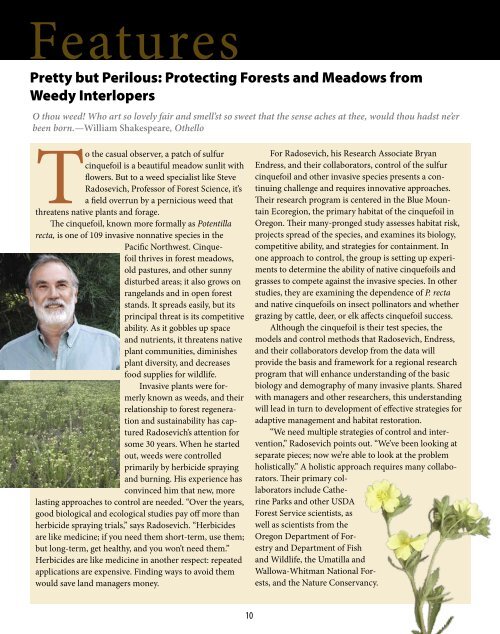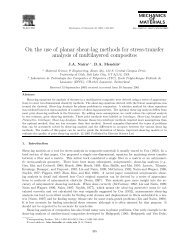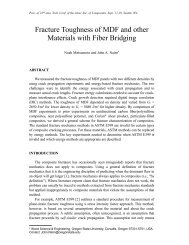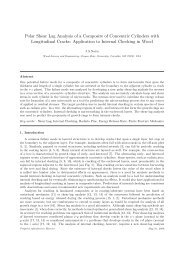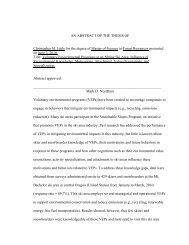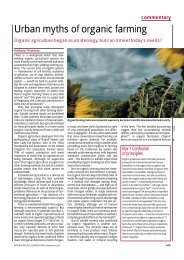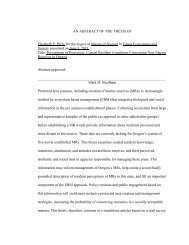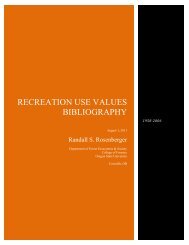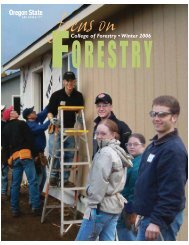College of Forestry - Oregon State University
College of Forestry - Oregon State University
College of Forestry - Oregon State University
You also want an ePaper? Increase the reach of your titles
YUMPU automatically turns print PDFs into web optimized ePapers that Google loves.
Features<br />
Pretty but Perilous: Protecting Forests and Meadows from<br />
Weedy Interlopers<br />
O thou weed! Who art so lovely fair and smell’st so sweet that the sense aches at thee, would thou hadst ne’er<br />
been born.—William Shakespeare, Othello<br />
To the casual observer, a patch <strong>of</strong> sulfur<br />
cinquefoil is a beautiful meadow sunlit with<br />
flowers. But to a weed specialist like Steve<br />
Radosevich, Pr<strong>of</strong>essor <strong>of</strong> Forest Science, it’s<br />
a field overrun by a pernicious weed that<br />
threatens native plants and forage.<br />
The cinquefoil, known more formally as Potentilla<br />
recta, is one <strong>of</strong> 109 invasive nonnative species in the<br />
Pacific Northwest. Cinquefoil<br />
thrives in forest meadows,<br />
old pastures, and other sunny<br />
disturbed areas; it also grows on<br />
rangelands and in open forest<br />
stands. It spreads easily, but its<br />
principal threat is its competitive<br />
ability. As it gobbles up space<br />
and nutrients, it threatens native<br />
plant communities, diminishes<br />
plant diversity, and decreases<br />
food supplies for wildlife.<br />
Invasive plants were formerly<br />
known as weeds, and their<br />
relationship to forest regeneration<br />
and sustainability has captured<br />
Radosevich’s attention for<br />
some 30 years. When he started<br />
out, weeds were controlled<br />
primarily by herbicide spraying<br />
and burning. His experience has<br />
convinced him that new, more<br />
lasting approaches to control are needed. “Over the years,<br />
good biological and ecological studies pay <strong>of</strong>f more than<br />
herbicide spraying trials,” says Radosevich. “Herbicides<br />
are like medicine; if you need them short-term, use them;<br />
but long-term, get healthy, and you won’t need them.”<br />
Herbicides are like medicine in another respect: repeated<br />
applications are expensive. Finding ways to avoid them<br />
would save land managers money.<br />
For Radosevich, his Research Associate Bryan<br />
Endress, and their collaborators, control <strong>of</strong> the sulfur<br />
cinquefoil and other invasive species presents a continuing<br />
challenge and requires innovative approaches.<br />
Their research program is centered in the Blue Mountain<br />
Ecoregion, the primary habitat <strong>of</strong> the cinquefoil in<br />
<strong>Oregon</strong>. Their many-pronged study assesses habitat risk,<br />
projects spread <strong>of</strong> the species, and examines its biology,<br />
competitive ability, and strategies for containment. In<br />
one approach to control, the group is setting up experiments<br />
to determine the ability <strong>of</strong> native cinquefoils and<br />
grasses to compete against the invasive species. In other<br />
studies, they are examining the dependence <strong>of</strong> P. recta<br />
and native cinquefoils on insect pollinators and whether<br />
grazing by cattle, deer, or elk affects cinquefoil success.<br />
Although the cinquefoil is their test species, the<br />
models and control methods that Radosevich, Endress,<br />
and their collaborators develop from the data will<br />
provide the basis and framework for a regional research<br />
program that will enhance understanding <strong>of</strong> the basic<br />
biology and demography <strong>of</strong> many invasive plants. Shared<br />
with managers and other researchers, this understanding<br />
will lead in turn to development <strong>of</strong> effective strategies for<br />
adaptive management and habitat restoration.<br />
“We need multiple strategies <strong>of</strong> control and intervention,”<br />
Radosevich points out. “We’ve been looking at<br />
separate pieces; now we’re able to look at the problem<br />
holistically.” A holistic approach requires many collaborators.<br />
Their primary collaborators<br />
include Catherine<br />
Parks and other USDA<br />
Forest Service scientists, as<br />
well as scientists from the<br />
<strong>Oregon</strong> Department <strong>of</strong> <strong>Forestry</strong><br />
and Department <strong>of</strong> Fish<br />
and Wildlife, the Umatilla and<br />
Wallowa-Whitman National Forests,<br />
and the Nature Conservancy.<br />
10


